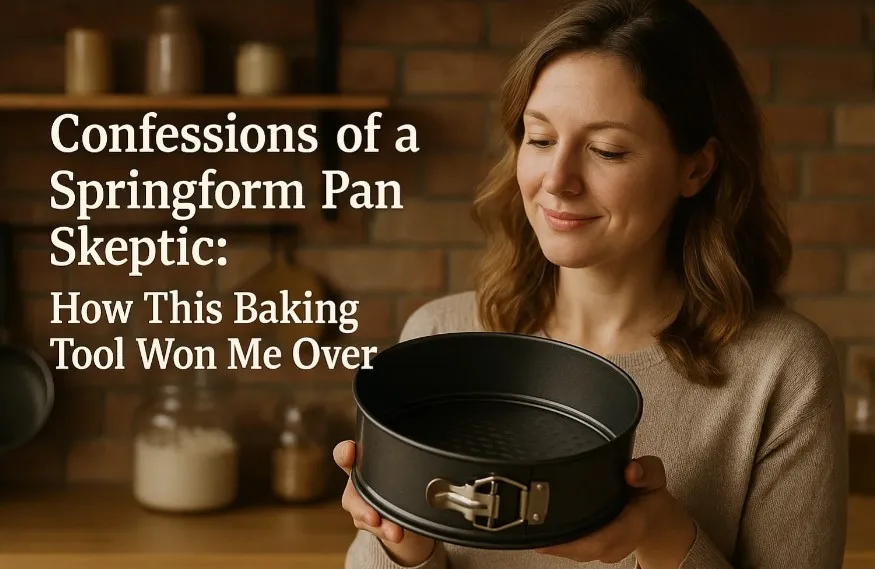A springform pan is used for delicate baked goods that are difficult to remove from a regular pan—like cheesecakes, tortes, or deep-dish quiches—thanks to its removable side latch that releases the dessert without flipping or damaging it!
If you’d asked me last year what my least-used kitchen gadget was, I’d have pointed straight at my springform pan. (Full confession: I once used it to serve nachos at a party, thinking it was a fancy chip bowl.) But—turns out—springform pans are basically undercover superstars in the baking world.
From delicate cheesecakes to savory deep-dish dinners, these pans can handle more than you’d expect. Let me take you on a slightly messy, wholly enthusiastic tour of my springform-shaped kitchen adventures.
Springform Pan Mishaps & Marvels: An Unexpected Journey
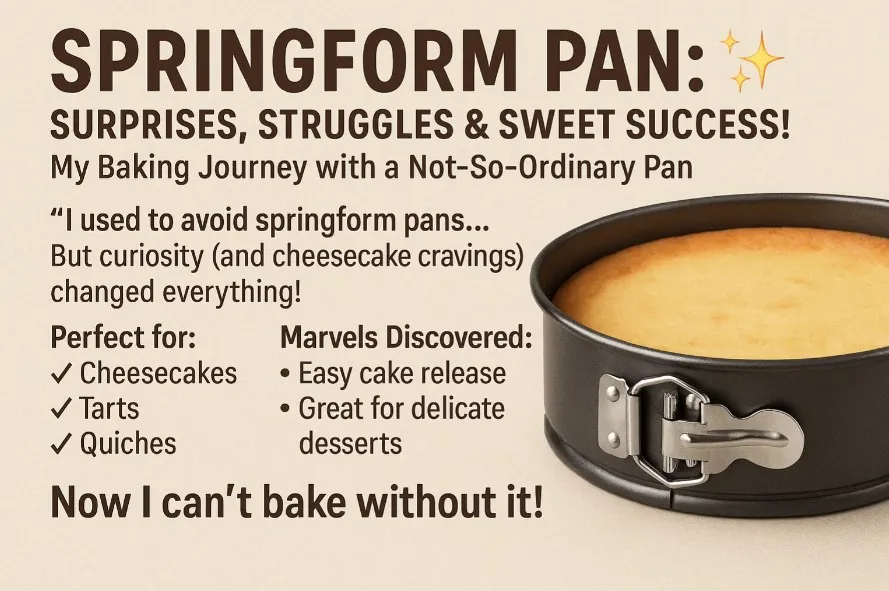
I’ll admit it: I was once a springform pan skeptic. For years, I eyed this odd baking tool with suspicion, convinced it was just another kitchen gadget destined to gather dust. But as someone who loves trying new cheesecake recipes and dabbling in tarts and quiches, curiosity finally got the better of me. What followed was a journey filled with mishaps, marvels, and a newfound appreciation for the humble springform pan.
My First Springform Catastrophe: Cheesecake Batter on the Floor, Not the Plate!
Let’s start with my most memorable springform pan disaster. I had spent the afternoon whipping up my first ever homemade cheesecake. The batter was silky, the crust was golden, and my anticipation was sky-high. I poured everything into the pan, popped it in the oven, and waited.
About 20 minutes later, I caught a whiff of something burning. I opened the oven door to find cheesecake batter oozing out the bottom of the pan, pooling onto the oven floor. Apparently, I hadn’t locked the sides properly—a rookie mistake that left me scraping burnt batter for hours.
As frustrating as that was, it taught me a crucial lesson: learning from leaks is part of mastering the springform pan. Research shows that these pans are designed for easy release, especially for delicate baked goods like cheesecakes and tarts. But if you don’t assemble them correctly, you’ll end up with a mess.
I learned to always double-check the latch and, just in case, line the bottom with parchment paper for extra insurance.
Redemption: Nailing My First Ice Cream Cake (and Becoming Friends with My Freezer)

After my cheesecake fiasco, I almost gave up on the springform pan. But then I stumbled on a recipe for an ice cream cake. The instructions called for layering softened ice cream and cookie crumbs in a springform pan, then freezing overnight.
This time, I made sure the pan was locked tight. The next day, I unclipped the sides and—miracle of miracles—the cake slid out perfectly, with clean, crisp edges. No sticking, no crumbling, just a picture-perfect dessert.
That moment was a game-changer. I realized why so many bakers swear by springform pans for ice cream cakes and other layered desserts. The removable sides make it easy to unmold even the most delicate creations without damaging their shape. As Mary Berry puts it,
‘A springform pan is my go-to for stress-free unmolding!’
More Than Desserts—Springform Lasagna? Turns Out, It’s a Real Thing
Once I got comfortable with the basics, I started experimenting. Could a springform pan handle more than just cheesecake recipes and tarts? Turns out, yes. I tried making a deep-dish lasagna, layering noodles, sauce, and cheese right up to the rim.
The result? A tall, impressive slice that held its shape beautifully when I released the pan’s sides. It was a revelation: springform pans aren’t just for sweet treats—they’re perfect for savory baking, too.
I even used the pan to press a quiche crust, though I’ll confess, I forgot to lock the sides again. Lesson learned (again): always check the latch before adding your filling.
Still, it was proof of the pan’s versatility. From tarts and quiches to deep-dish pizza and savory pies, the springform pan can do it all.
Springform Pan Sizes, Recipes, and Materials: A Quick Guide
If you’re considering adding a springform pan to your kitchen, here’s a quick look at the basics. Research indicates that these pans typically range from 6 to 10 inches in diameter, making them suitable for everything from small tarts to family-sized cheesecakes. They’re available in several materials—steel, anodized aluminum, and even silicone—each offering different benefits for baking and cleanup.
| Feature | Details |
|---|---|
| Sizes | Typically 6 to 10 inches in diameter |
| Common Recipes | Cheesecakes, ice cream cakes, savory pies, tarts |
| Material Options | Steel, anodized aluminum, silicone |
Springform pans have truly earned their place in my kitchen. Whether you’re tackling classic cheesecake recipes, experimenting with tarts and quiches, or venturing into savory baking like lasagna or deep-dish pizza, this tool is more versatile than I ever imagined. And yes, I’ve learned to always check the latch—because even the best baking adventures come with a few surprises.
Not Just for Cheesecake: The Many Faces of the Springform Pan
I’ll admit it: for years, I thought the Springform Pan was just a one-trick pony. Cheesecake, cheesecake, cheesecake—maybe a fancy New York style if I was feeling adventurous. But after a few baking experiments (and more than one kitchen disaster), I realized I’d been seriously underestimating this humble piece of bakeware. The Springform Pan isn’t just a cheesecake specialist—it’s a true baking essential with a surprising range of talents.
Beyond Cheesecake: A World of Layered Desserts
Let’s start with the obvious: the Springform Pan is famous for its easy cake release. That latch mechanism? It’s not just clever engineering—it’s a lifesaver for anyone who’s ever tried to pry a delicate dessert out of a regular cake tin. But cheesecakes are just the tip of the iceberg.
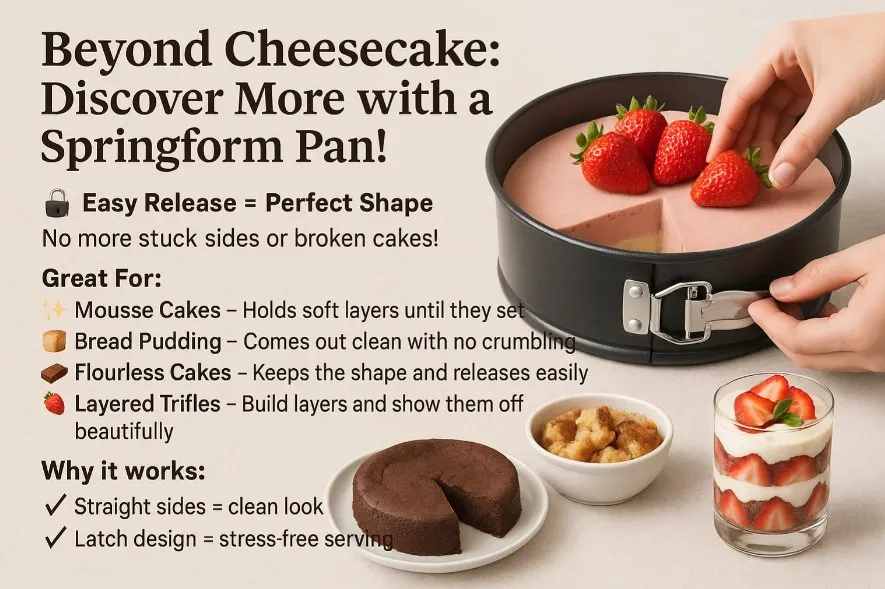
Research shows that springform pans are perfect for mousse cakes, bread pudding, flourless cakes, and even layered trifles. The clean-sided presentation you get from a springform is hard to beat, especially when you want those layers to really shine.
- Mousse cakes: The pan holds soft, airy layers in place until set, then releases them with a satisfying click.
- Bread pudding: No more crumbling edges or stuck bottoms—just a neat, sliceable dessert.
- Trifles and flourless cakes: The straight sides and easy-release base mean you can build up layers and unmold with confidence.
I once built a no-bake trifle in my springform—just layered cake, custard, fruit, and whipped cream. When I popped the latch, the dessert held together perfectly, and those clean edges made it look like something out of a pastry shop. (Bonus: it’s a guaranteed way to impress your mother-in-law.)
Easy Release: The Secret Weapon for Delicate Desserts
If you’ve ever lost half your cake to the bottom of a pan, you know the pain. The springform’s easy-release design is a game-changer. The sides and base separate, so you don’t have to flip or wrestle your dessert out.
This is especially important for layered desserts and delicate bakes that need to keep their shape. Studies indicate that springform pans are essential for maintaining the structural integrity of desserts during removal—no more cracked cheesecakes or collapsed mousse cakes.
And it’s not just about sweets. I’ve used my springform for deep-dish pizza, savory bread puddings, and even a show-stopping chicken pot pie. The easy-release latch means you get a clean edge every time, whether you’re serving dessert or dinner.
Nonstick Coating: Cleanup Made Simple
Here’s a confession: I hate scrubbing pans. That’s why the nonstick coating on most modern springform pans is such a blessing. If you avoid metal utensils (trust me, it’s worth it), cleanup is usually a quick rinse and wipe. No more soaking or scraping. Research shows that nonstick coatings are widely available and reduce cleanup time, making the springform pan even more appealing as a baking essential.
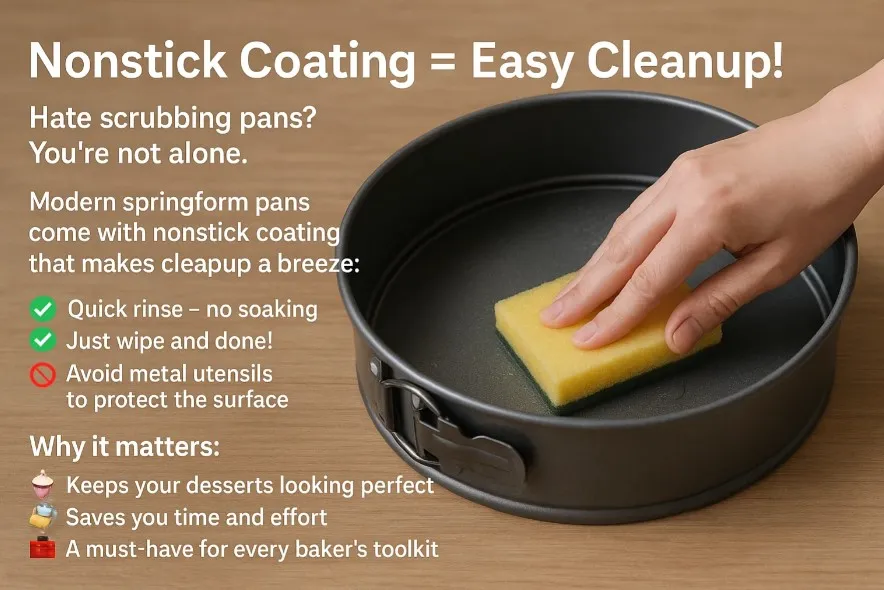
For anyone building a collection of baking essentials, a springform pan with a reliable nonstick coating should be at the top of the list. It’s not just about convenience—it’s about making sure your hard work in the kitchen pays off with beautiful results and minimal mess.
Why Presentation Matters
There’s something about that clean-sided look that takes a dessert from homemade to bakery-worthy. As celebrity baker Duff Goldman puts it:
‘If you love presentation, a springform should always be in your toolkit.’
I couldn’t agree more. Whether you’re unmolding a delicate mousse cake or slicing into a deep-dish pizza, the springform pan delivers that signature clean edge every time.
Springform Pan Versatility at a Glance
| Dessert Types | Springform Pan Feature | Nonstick Coating |
|---|---|---|
| Cheesecakes, mousse cakes, bread pudding, trifles, flourless cakes | Easy-release latch for intact desserts | Widely available, reduce cleanup time |
The more I use my springform pan, the more I realize it’s not just for cheesecake. It’s a versatile, reliable tool that makes baking—and serving—layered desserts and savory dishes easier, cleaner, and a lot more fun.
Why Every Kitchen Needs One (Even If You Only Bake Once a Year)
I’ll admit it: I used to think a springform pan was just another specialty gadget destined to collect dust in the back of my cabinet. As someone who bakes sporadically—usually only when birthdays or holidays demand it—I figured my trusty sheet pans and loaf tins were enough. But after a few years (and more than a few dessert disasters), I’ve come to realize that a springform pan isn’t just for the pros or the overly ambitious.
In fact, it’s a versatile kitchen tool that quietly solves problems you didn’t even know you had, whether you’re into sweet treats or savory baking adventures.
Let’s start with the basics. A springform pan is designed with a removable ring that latches around the base, allowing you to release whatever you’ve baked without flipping, prying, or praying it comes out in one piece.
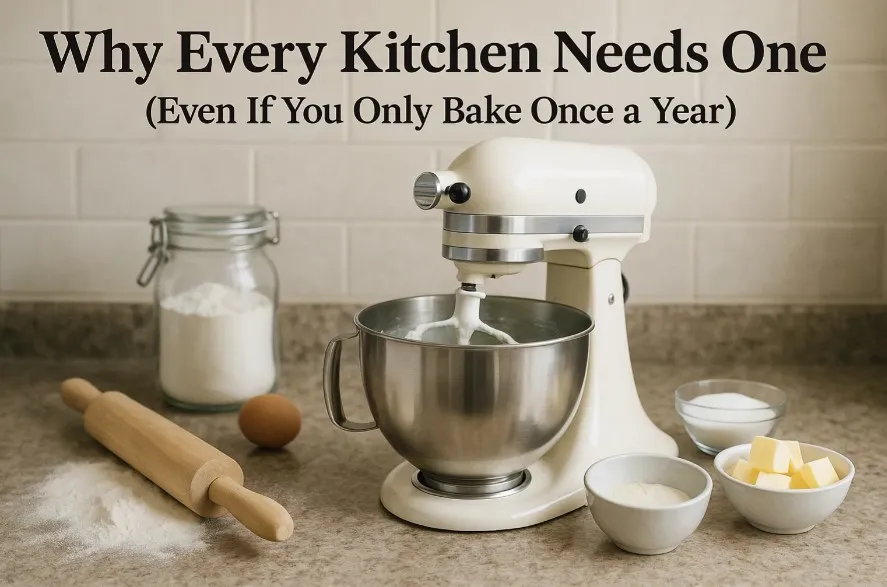
This simple innovation makes a world of difference, especially for delicate desserts like cheesecakes, flourless cakes, and fruit tarts. Research shows that springform pans are ideal for recipes where presentation matters—think clean edges, perfect layers, and no crumbling disasters. I’ve found that even my most amateur attempts look surprisingly professional, at least visually. As Christina Tosi once said,
‘It’s the only pan that consistently makes me look like I know what I’m doing.’
But here’s what surprised me: springform pans aren’t just for sweet recipes. They’re a secret weapon for savory baking too. I never thought I’d make deep-dish pizza or chicken pot pie in what I once called my “cheesecake pan,” but it turns out the design is perfect for hearty, layered meals.
The tall sides and easy-release mechanism mean you can build up generous fillings—lasagna, quiche, even bread pudding—without worrying about sticking or structural collapse. And yes, serving lasagna from a cake pan is a guaranteed conversation starter at dinner parties.
There’s something oddly satisfying about slicing into a savory dish and lifting out a perfectly intact wedge, no spatula acrobatics required.
One of the most underrated perks of a springform pan is how it handles frozen desserts. If you’ve ever tried to unmold an ice cream cake from a standard pan, you know the struggle: melting edges, lost layers, and a general sense of defeat. With a springform, you can layer, freeze, and release your creation with zero drama.
The pan holds everything in place as it sets, so you get those crisp, Instagram-worthy layers. Studies indicate that this is especially useful for recipes like mousse cakes, trifles, and anything else that needs to chill or set before serving.
Maintenance and care are refreshingly simple. Most springform pans are made from durable materials like steel or anodized aluminum, and many come with nonstick coatings for easy cleanup. My only real tip—learned the hard way—is to dry the pan thoroughly after washing. Any lingering moisture can lead to rust, especially around the latch and base.
A quick towel dry and a minute in a warm oven does the trick. It’s a small habit that keeps your pan in top shape for years.
If you’re like me and only bake a few times a year, you might wonder if it’s worth making space for yet another pan. But here’s the thing: a springform pan isn’t just for showstopping desserts. It’s a practical, versatile kitchen tool that makes baking (and even cooking) easier, cleaner, and more enjoyable.
From flourless cakes and fruit tarts to deep-dish pizza and chicken pot pie, the possibilities are broader than I ever imagined. And honestly, there’s a certain confidence that comes from knowing your creation will come out of the pan looking as good as it tastes.
So whether you’re a seasoned baker or a once-a-year experimenter, don’t underestimate the humble springform pan. It’s the unsung hero of the kitchen—one that quietly elevates your baking game, one release at a time.
The springform pan is so much more than a cheesecake vessel—think layered desserts, savory pies, and a shortcut to impressively easy presentation. Whether you’re skeptical or a baking pro, it’s well worth a spot in your cupboard.
Frequently Asked Questions
Can I use a springform pan for regular cakes?
Yes, but it’s best for delicate or sticky batters. For standard cakes, a regular cake pan works fine.
Do I need to grease a springform pan?
Yes! Even non-stick pans benefit from a light coating of butter or parchment paper.
Can I use it in a water bath?
Absolutely! Just wrap the outside in foil to prevent water from seeping in.
Are all springform pans leak-proof?
Not always. For wet batters (like cheesecake), place a baking sheet underneath to catch drips.
Tips for Using a Springform Pan
🔹 Line the Bottom – Use parchment paper for easy removal.
🔹 Don’t Overfill – Leave some space for rising.
🔹 Cool Before Releasing – Let cakes cool slightly to avoid breaking.
🔹 Check the Seal – Ensure the latch is tight before pouring batter.
“The secret to a perfect cheesecake? Patience and a good springform pan.” – Chef Michael
Common Mistakes to Avoid
❌ Opening the Pan Too Soon – Wait until the cake is fully cooled.
❌ Skipping Greasing – Even non-stick pans need it.
❌ Using a Knife to Release – The sides should pop open easily—no prying needed!
Best Springform Pans to Try
Looking for a reliable pan? Here are top picks:
- Nordic Ware – Sturdy and even heating.
- Fat Daddio’s – Professional-grade with a tight seal.
- Wilton – Affordable and non-stick.
“Invest in a good springform pan—it’s worth every penny for stress-free baking.” – Emily, Pastry Chef
Conclusion
So, what is a springform pan used for? It’s the ultimate tool for hassle-free baking, especially for delicate desserts like cheesecakes, tarts, and no-bake treats. With its removable sides and easy release, you’ll get perfect results every time. Whether you’re a beginner or a pro, this pan is a game-changer in the kitchen.
Ready to bake? Grab a springform pan and try your next dessert with confidence!

